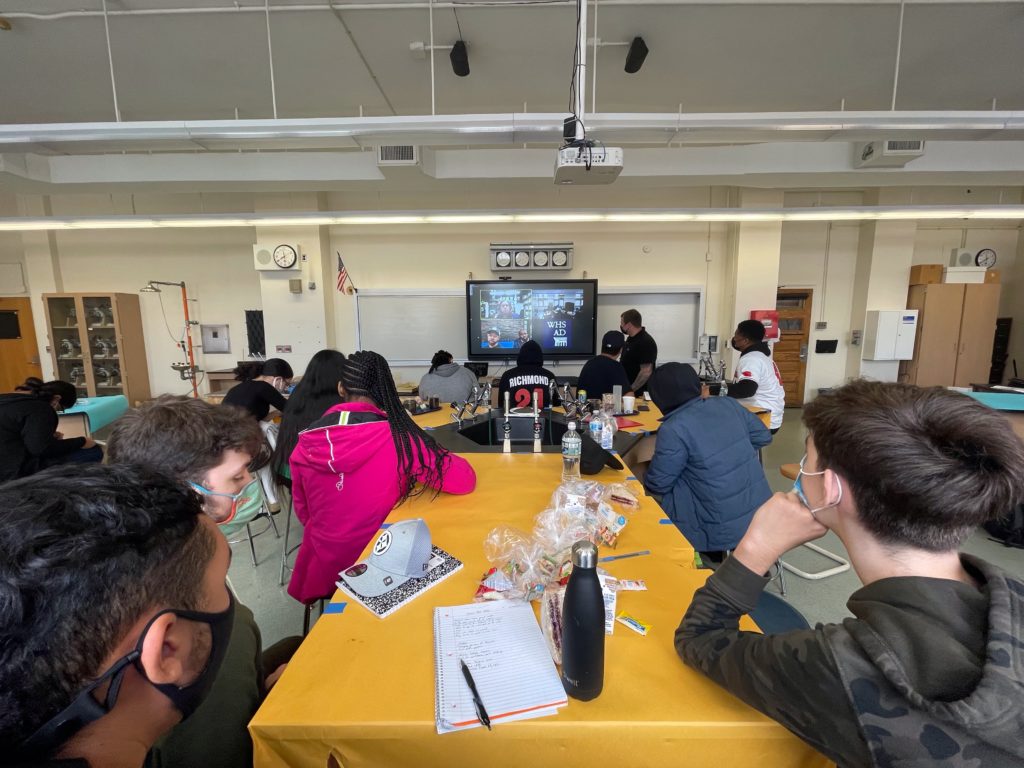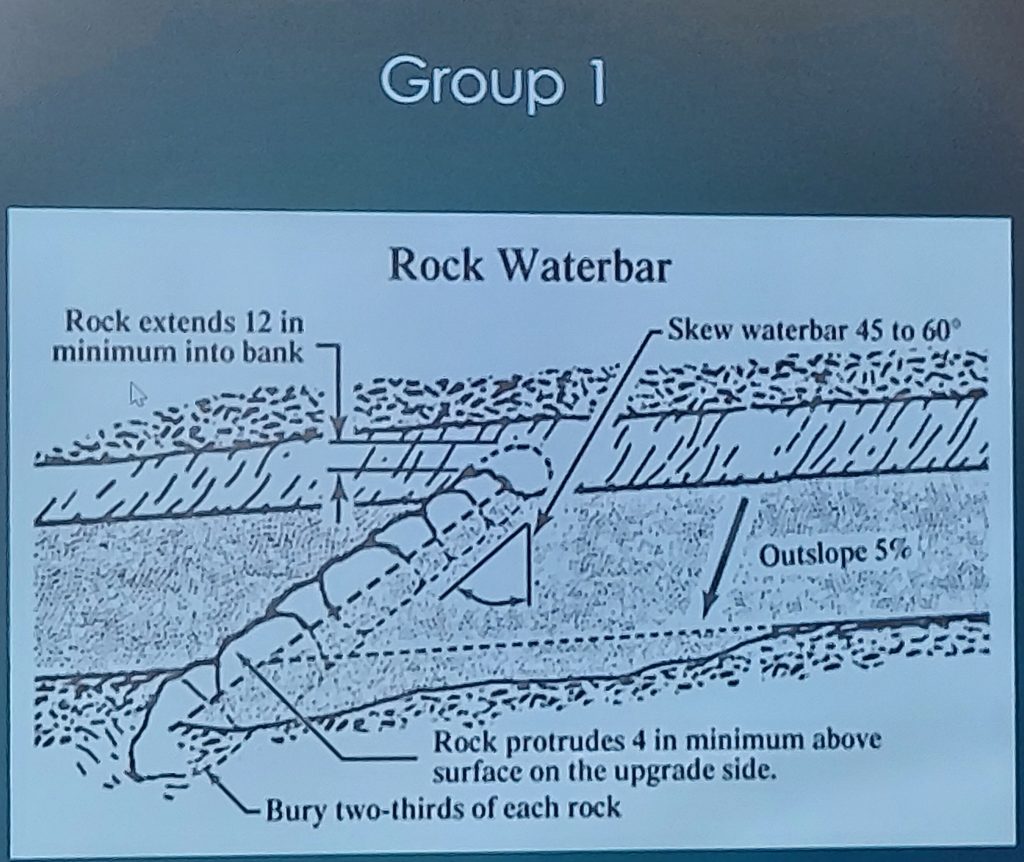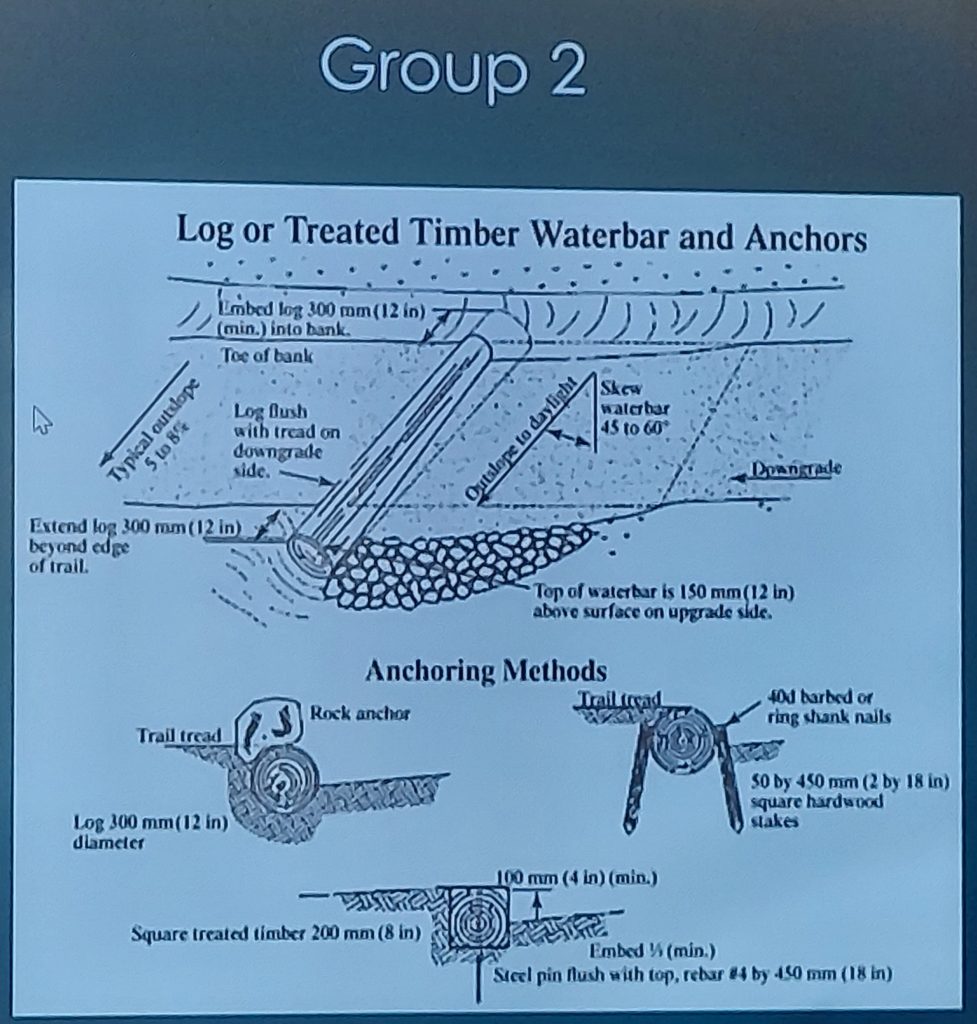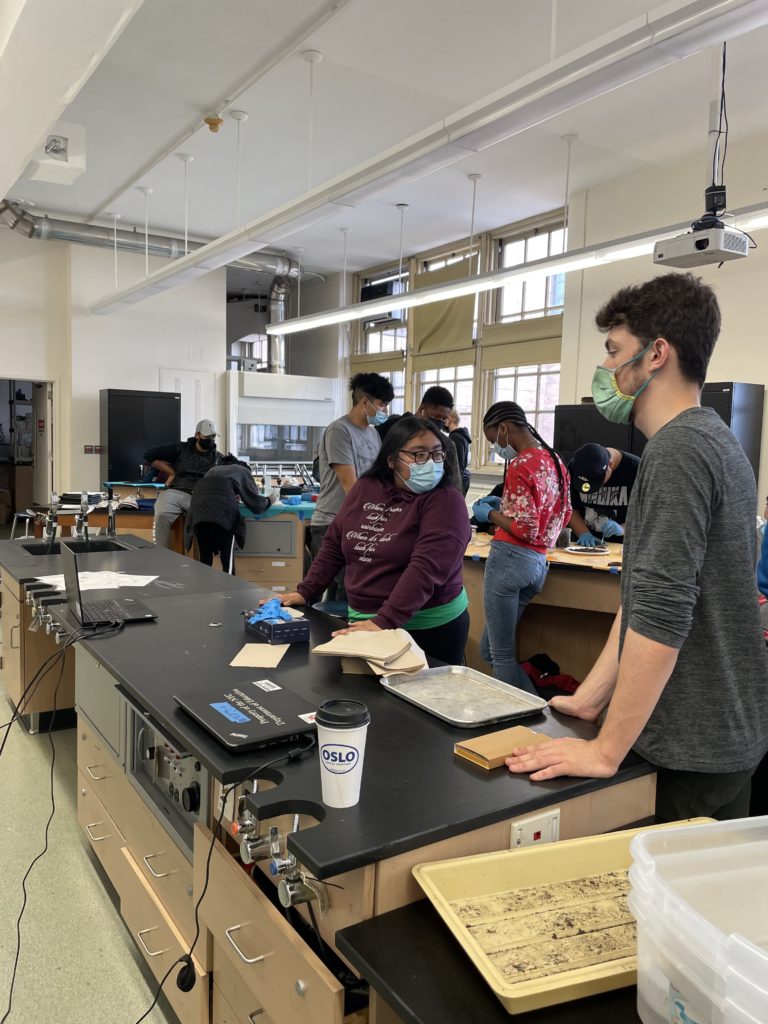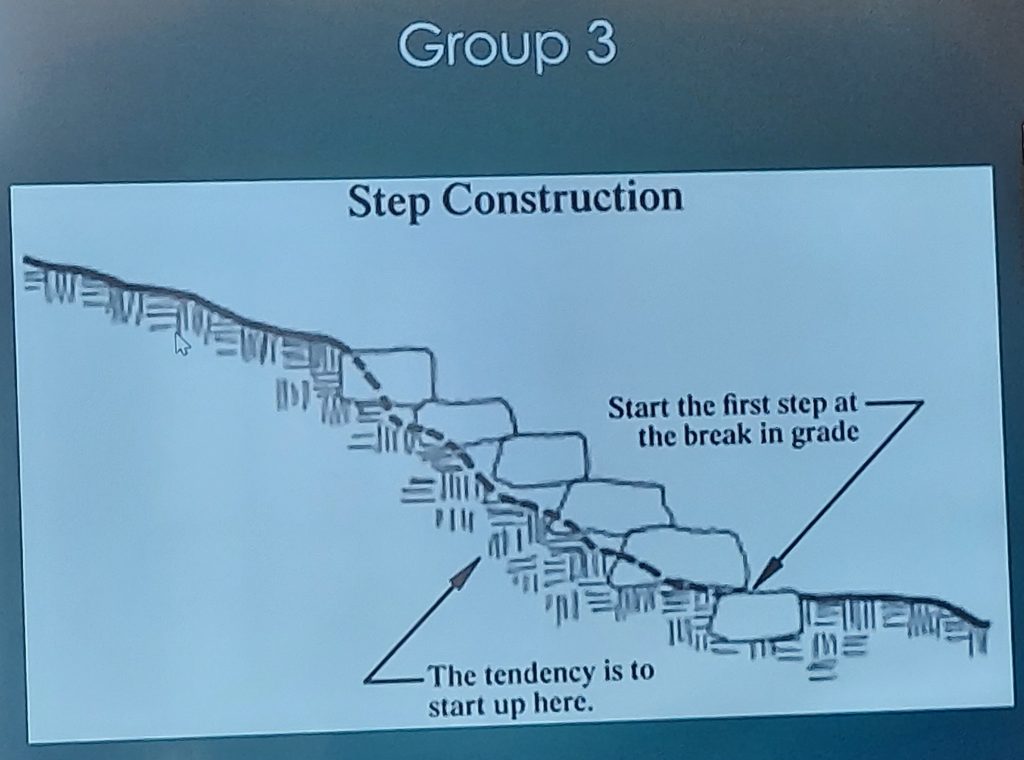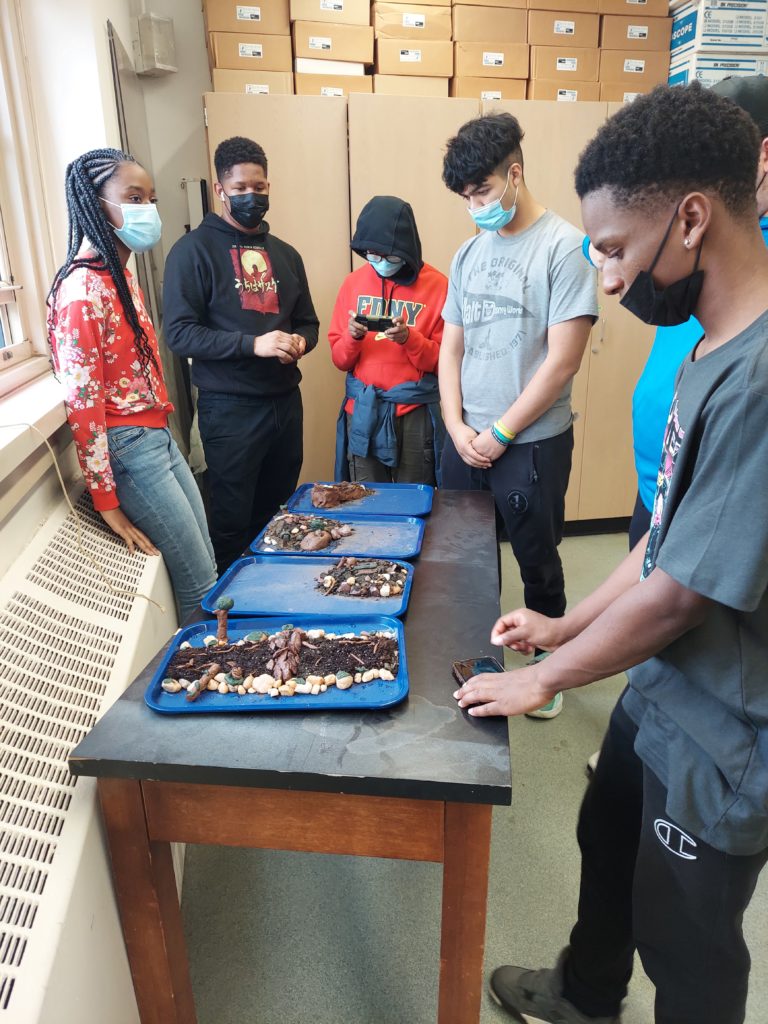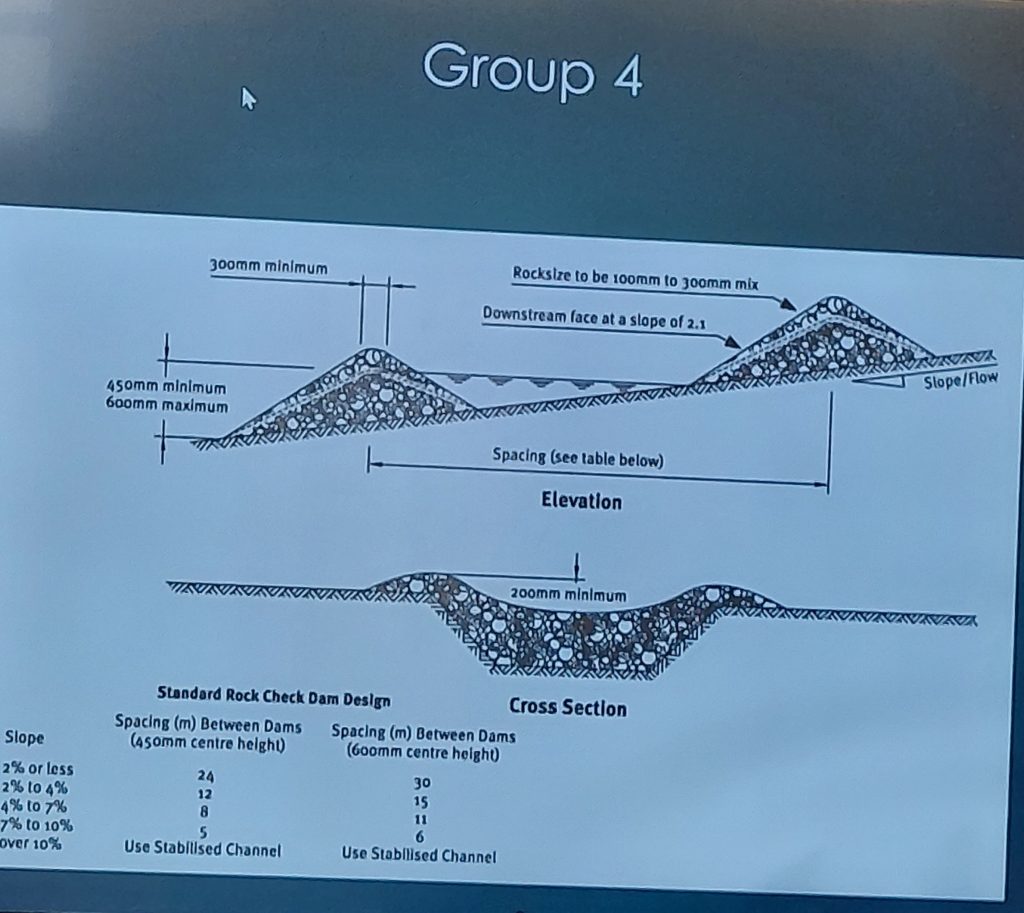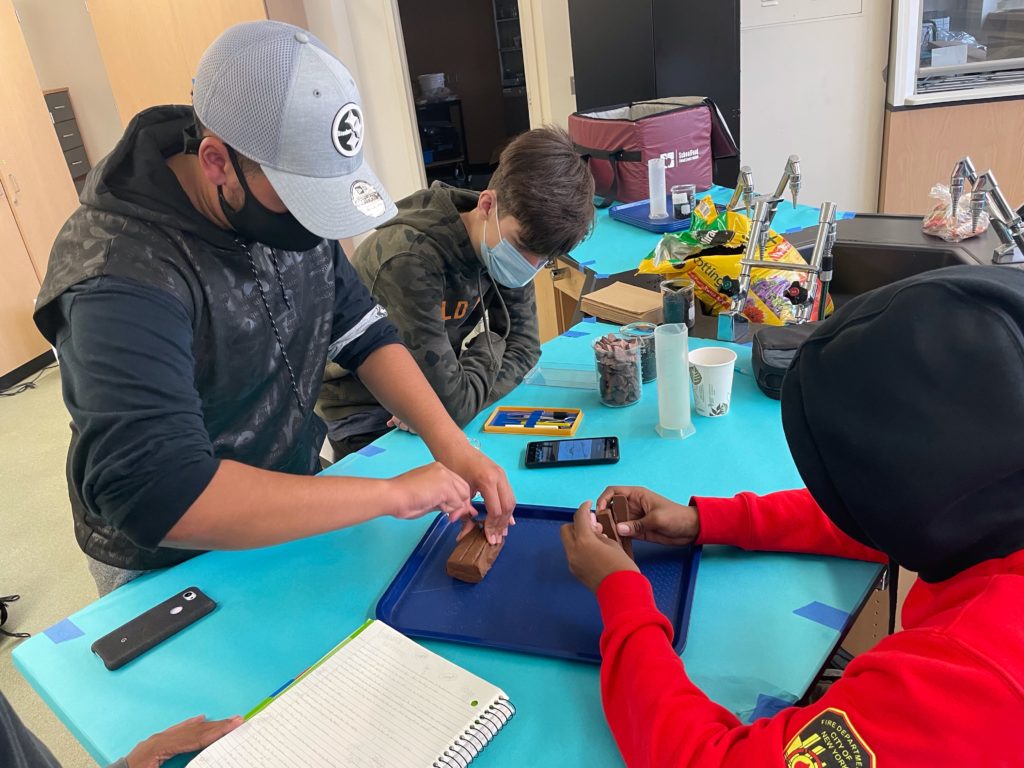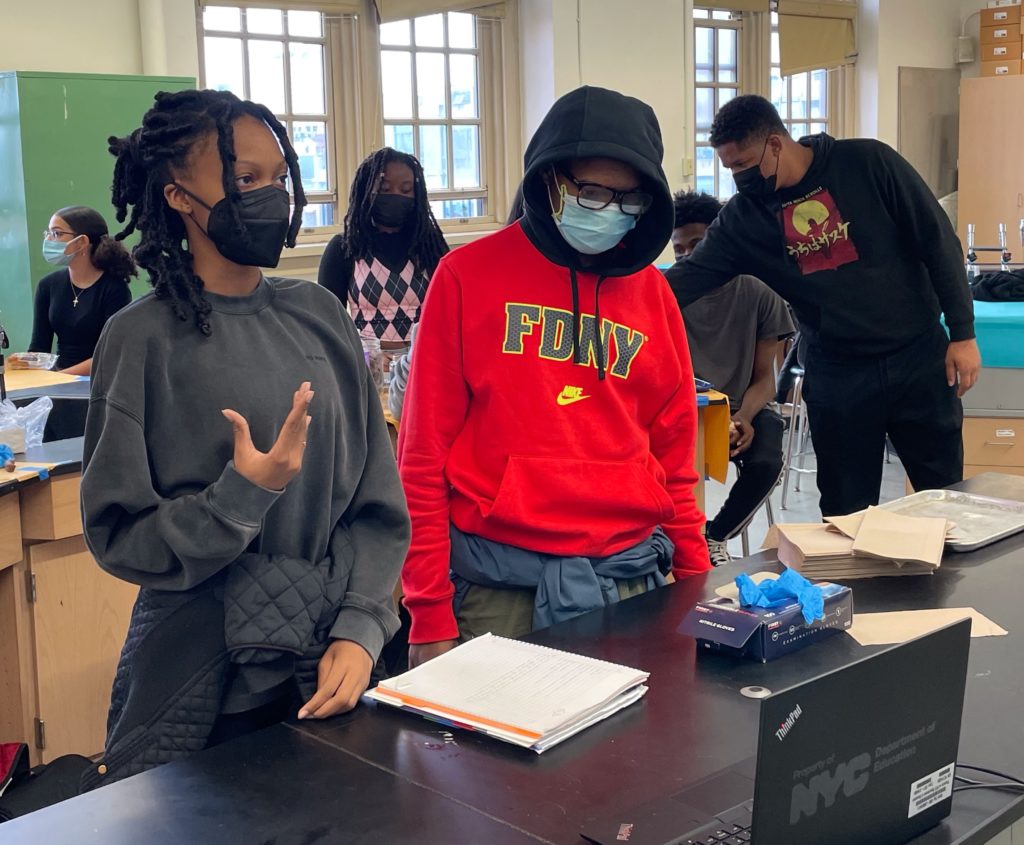On Tuesday, October 26, a group of WHSAD students, who are part of My Brother’s and My Sister’s Keeper groups, had the opportunity to go on a virtual trip and work on a hands-on project in collaboration with the Greenbelt in Staten Island. During the session, each of the four groups constructed a model based on real-life designs. Group 1 had to construct a “Rock Waterbar,” group 2 worked on the “Log or Treated Timber Waterbar and Anchors,” group 3 worked on “Step Construction Design”, and group 4 worked on a model of a water bar that shows two sets of rocks stopping and redirecting a downstream flow of water. In parks and trails like High Rock, these structures assist in managing water flow that is due to precipitation. These various designs operate to direct and channel water away from routes, allowing the significant corridors to remain free of large puddles and water collections while not negatively impacting the ecology.
During the presentation, we learned more about the Greenbelt’s history. Following the completion of the Verrazano-Narrows Bridge in 1964, an effort was made to link the tracks that now make up the Greenbelt into one contiguous park in response to the area’s expanding population. Permanently transforming the terrain, engineers and planners removed woodlands and filled streams, ponds, and marshes. The creation of the unified Greenbelt was well underway, with its centerpiece, High Rock Park, in 1965 and its formal designation in 1984. Much of the park’s tidal and freshwater marshes, forests, open fields, and meadows have kept their original condition since the main focus of the people who work on the Greenbelt is to conserve its history. As a method of safeguarding a section of the island’s natural ecosystem, an outcrop of unique serpentine bedrock that runs the length of the North American continent can be found within the park. The Greenbelt is one of the few sites in the world where this thick, waxy, green, and brown granite may be seen above ground. The flow of the Wisconsin glacier is seen in kettle holes, steep slopes, and big rocks. Due to the variety of soils deposited during the glacier’s passage, the region could support a wide range of plant and animal species.
In the following narratives, participating students provide thoughts on the session and their designs.
Group 1
Matthew Zaczeniuk
The 2nd session of the High Rock Greenbelt project was very exciting. In this session we received the chance to work on a hands-on project in which we constructed and simulated different structures based on real life models. We designed these structures to help control water and rainfall in parks and trails such as High Rock. This was a more scientific study on how different structures work to direct and divert water off of pathways and help keep the main paths clear of collecting water while not negatively affecting the surrounding ecosystem.
I was very excited to participate in this project because I love learning with a hands-on approach, and I was eager to challenge myself and my team to try and create the most accurate and well represented model. During this project, I participated in group 1 where we had to construct a “Rock Waterbar”. I don’t think I was the team captain, but my teammates always looked at me for approval when deciding where and how to put and place things, so I’ll say I was the captain. My teammates for the project were Amelia Velez, Sheldon Richmond, and Adam Fatihi. We had a great time creating the model and using the resources that were provided to us. For the model we used a wide variety of materials such as clay which we used to secure big red stones to the board to represent them being ⅔ of the way in the ground as represented on the graph, as well as smaller white stones, and two types of dirt. We used a coarse dry dirt as a base to lay down the structure of the path, then used more rich potting soil to act as the ground layer and to make it look higher quality and more like the ground of an actual path. We laid down the soils first and then cut a section of it in two to make room for the clay support. We then stuck the stones in the clay at around a 45 degree angle to match the graph, and then covered the clay with the dirt so nobody could see it. We used the rest of the clay to create trees and fallen logs as well as thin round sheets of green clay on top of the logs and rocks to represent moss. We then presented our final submission to Chris Ricker and his team to review. After seeing all the other models, the committee crowned our team with the best looking model out of all.
All in all, I really enjoyed this project. I loved working with my team and iterating on our model every step of the way. We put a great deal of effort into designing and building the model, and it was amazing to hear Chris and his team think that ours was the best. I was honored to take the title, but I think all the projects came out great in their own respects. We had a lot of fun and it’s great seeing what we’re doing here. I’m happy to be participating in such a wonderful project after more than a year sitting at home and now working hands-on. I can’t wait till we can finally go out and participate in real field trips, and I’m excited to see how this project will evolve in the near future.
Marc Joseph
My experience yesterday in the High Rock session was very informative. We learned about the different paths made in the Greenbelt to disperse water to avoid possible floods and create more accessibility. Each group was assigned a different concept to carry out to regulate the water so it doesnt stay in one place. There were 4 groups in general to carry out these solutions which would be implemented in high rock park.
The group I was a part of was group 1, and the design we were assigned was the Rock Waterbar which used a row of rocks to regulate the water. Our design consisted of a row of rocks on the side with soil in between with a row of rocks in the middle buried two thirds in the soil. The purpose of this design was to guide the water downhill so it doesn’t sink down in one place and create mud puddles. After seeing the design provided to us on the slides, we went about constructing it. We also looked into key things in the design like “Putting the rocks two-thirds of the way in the ground. Afterwards we got creative and used the clay to represent trees and worms to give it more personality.
Adam Fatihi
After participating in yesterday’s session, my peers Matthew, Amelia, Michael, and I had to create a design. The purpose of this design was to show how the rock water bar will control the water and distribute it to the sides so then the park doesn’t flood. The design we made was a rock waterbar on a dirt path lined with stones, trees, algae, and twigs. We were able to create this by using colored clay such as brown clay and green clay, design materials provided to us such as scalpels, and rocks. The practical purpose of these models is that we can get a sense of how this will look in real life and simulate how effective it would be with controlling water and distributing it toward the sides of the path.
The way my group went about doing this model is by working together and sharing ideas on how to do the model. We agreed upon doing a double layer of dirt with some buried rocks to help push the water to the side. After this, we decided to line the edges with stones to match the rock waterbar diagram and created a line of stones going across the dirt. Before we were finished, we remembered that Chris told us sometimes algae and trees can be on top of the path. By integrating this information, we added it to our model to create a better representation of an accurate rock waterbar and made our model more realistic.
Group 2
Magaly Aspiroz
On Tuesday we met in the lab for a project in participation with High Rock. I worked with Luke Skyers, Chelsea Garcia, and Mahalia Sainteloi. We were group 2 and we made a model that represented the second image of systems, which was the Log or Treated Timber Waterbar and Anchors. The image given showed some sort of hill with a log laying on it, almost as if it were a slide. Apparently, it was a system for a waterbar. In the image it was also shown that rocks seemed to hold the log in place. Based on the description given by Chris and Kat, we thought of different ways to portray the image using a model made from soil, rocks and clay. We spent about 2 minutes thinking of how to start and place the soil and the log. The image had an embedded log in the soil, so instead of burying it in a mountain of dirt, we chose to make a hill with the log laying on its side with rocks, which showed the system the way it was in the explanation from the picture.
To make the hill we used dirt since we thought that it would give the model a realistic look. For the bottom part of the hill we used potted soil because it had white little pebbles, and we thought that it could look like little rocks. Then Mahalia used clay to make a plank. The clay that she used was brown so that it looked like wood planks and logs. Another member of my group members crafted a green log and placed it on top of the brown one to act as the logs that were shown in the image. Once that was done, we grabbed red and white rocks to put around the dirt and logs. When we finished, we presented the model and talked about why we modeled it the way we did. The feedback we got was helpful because we learned how to make the model look more realistic and that adding different things like trees and rocks helped the model look more interesting and creative, as this was the case with group 1 and 4.
Luke Skyers
Yesterday was the day to learn about the path you walk to get to the Greenbelt and how it helps people navigate through High Rock park. We also looked at the building in the Greenbelt and we tried to rebuild designs with the materials we had. We were supposed to work outside I think, but we had a heavy rain yesterday so we couldn’t do it.
Yesterday was fun because we got to build logs and land. I was in a team of 5, and I was not very sure what to do because this was my first time doing something like this. However, I had Mark and Mahalia help out with most of it. I think everyone did well, as every building came out well. It was great to meet the teachers, Chris and Kat, and hear what we are going to do here.
Group 3
Jeffery Hernandez
Who?
Our group 3 was the Step Construction group, and members were Kevin Garcia, Jeffrey Hernandez, Conrecia Blake, and Michael Nazario.
What is your design?
Our design was the Step Construction design. We were supposed to create a model on how the stone steps would get rid of water. We used clay in our design to represent the log barriers used for the trail and to prevent the water from going in any other direction but down. We also wanted to show the environment in High Rock, such as grass, trees, and boulders. We also used little stones to show the stone steps on the trail. We used the dirt and soil to represent the terrain of the Greenbelt. Finally, we sprinkled the water, to model how water from rain would go down the slope.
Why?
Our group chose to show the step construction as one of the more efficient but more staffing-needed designs. We modeled this design because we were trying to find the most efficient way to get rid of rain water on trails using the slope to our advantage so there wouldn’t be any erosion. Our design offers a quick way to get rid of water. Though at the same time, the placement of the stones would be difficult since there are many stones, and they weigh a lot to move around. With a limited budget, time, and workforce, it’s harder to build.
How?
Our group’s process of modeling this design was to demonstrate how the slope would benefit the trail. We wanted to show the surroundings well and how the setting would change with the addition of the stone steps. The little stones we chose to represent, we decided the stone steps make removing water easier. The rocks were thin and straight to make the process easier. We used a scalpel to cut and form the wooden log barriers. We placed the dirt to create the slope for our design, so we thought ahead to make sure that it would work. Furthermore, we used water droplets to represent the rainfall and see if our model worked. Some challenges were placing stones and dirt to make the design accurate.
Group 4
D’Artagnan Dyasi
Our activity for the day was to make a model for ways to slow down and stop water. Our model had two parts: the first, a wall of rocks that slows down the water when it impacts it, and the second,a ditch of dirt that absorbs some of the water and calms it before hitting a second wall of rock to come to a halt.
Overall the feedback was positive. The people from the park said from a cost standpoint, it was really efficient and cheap since it just used rock and dirt that could already if not mostly found in the parks. A problem I could see with our model was how easy it was to destroy by heavy rains and if people move around the rocks to fill the ditch between the two rock walls .But in an official placement, it would be fixed because two thirds of the rock would be under the ground.
Sebastian Psujek
My group consisted of D’Artagnan Dyasi, Ethanael Vega, Sheena Luke, and me. We were group 4, and we had to make models of our project constructing a waterbar model that demonstrates a downstream flow of water being stopped and redirected by two sets of rocks. The first set was to slow down the water so it wouldn’t go over the second set of rocks. Because of what it’s supposed to do, the first set was to be bigger than the second one but when the water is slow then the second set stops it. When we explored the rock waterboard design, it was interesting that you needed two but then you realize that if you only have one the water can move the rocks and dirt can just go over it.
When we were assigned to make one of the 4 groups we chose to do group 4.We were told that that was the hardest one so we took the challenge. We took clay, soil, rocks. We used the clay for the foundation and walls.Then the soil and rocks were for the barrier to stop/slow down the water. It was challenging as the foundation was hard to make as it was a slope and a steep slope, but we made it possible. After we did this, we learned how these waterbars help the trails survive.
Ethanael Vega
My group consisting of Sebastian, D’Artagnan, Sheena and I were assigned group project four by Mr. Codio and Mr. Chris. Mr. Chris warned us that number four would be the hardest of all the projects to replicate into a model. The image that was provided showed two versions of the model. One on an incline, and the other on a flat surface. Both were meant to achieve the same goal and prevent runoffs. My group tackled the incline version of the model.
My team figured that it indeed was the hardest model, yet we were able to replicate it to some degree. To create the incline itself, we borrowed clay from one of the other groups and molded it into a ramp, with one side starting from the surface of our tray, up to about an inch and a half on the other end. Once completed, we added two types of rocks, and two types of soils on each end.
When it came time for our group to present, D’Artagnan and Sheena explained to Mr. Codio and Mr. Chris the process we went through to create our model. As they spoke, Sebastian and I were demonstrating how the model would work in a real world scenario. So I poured some sink water into a beaker, and Sebastian placed the water onto our model. Unfortunately, Sebastian was using a baster to squirt out droplets of water which was taking too long. So I took the beaker and just poured some water onto our model, and our rocks and soil actually worked to block the water and contain it in one area. Water did flow through cracks in our model, so it wasn’t 100% perfect, but we proved that our model did work, and we received high praise for it from Mr. Chris.
Sheena Luke
I worked in Group 4 alongside Sebastian Psujek, D’Artagnan Dyasi, and Ethanael Vega. The group constructed a model of a waterbar that shows two sets of rocks stopping and redirecting a downstream flow of water. Compared to rocks at the bottom of the slope, the first set of rocks, those placed higher on the slope, had a smaller amount. This difference corresponds to their responsibilities. As Chris pointed out, the water needs to be slowed down before it reaches the last set of rocks (stones) since an impact at full force would cause the stones to move out of their desired position and erode. That is the purpose of the first set. By the time the water passes through the first set of rocks, the flow will be slowed enough for the bottom stone to completely stop it.
Our model was made from clay, soil, rocks, and water. Clay was used as a base, and dry soil was applied over it. For the purpose of replicating the soil on the site, we used dry soil, focusing on its ability to absorb water. The absorption of water plays a big role in getting rid of water flows that threaten the conservation of a trail. It is possible to redirect water, but this does not eliminate it. Instead, it prevents the water from crossing the trail threshold. Water fully dissipates when absorbed into the soil, which is why the dry soil is an important component in our model.

